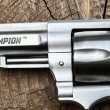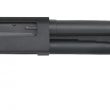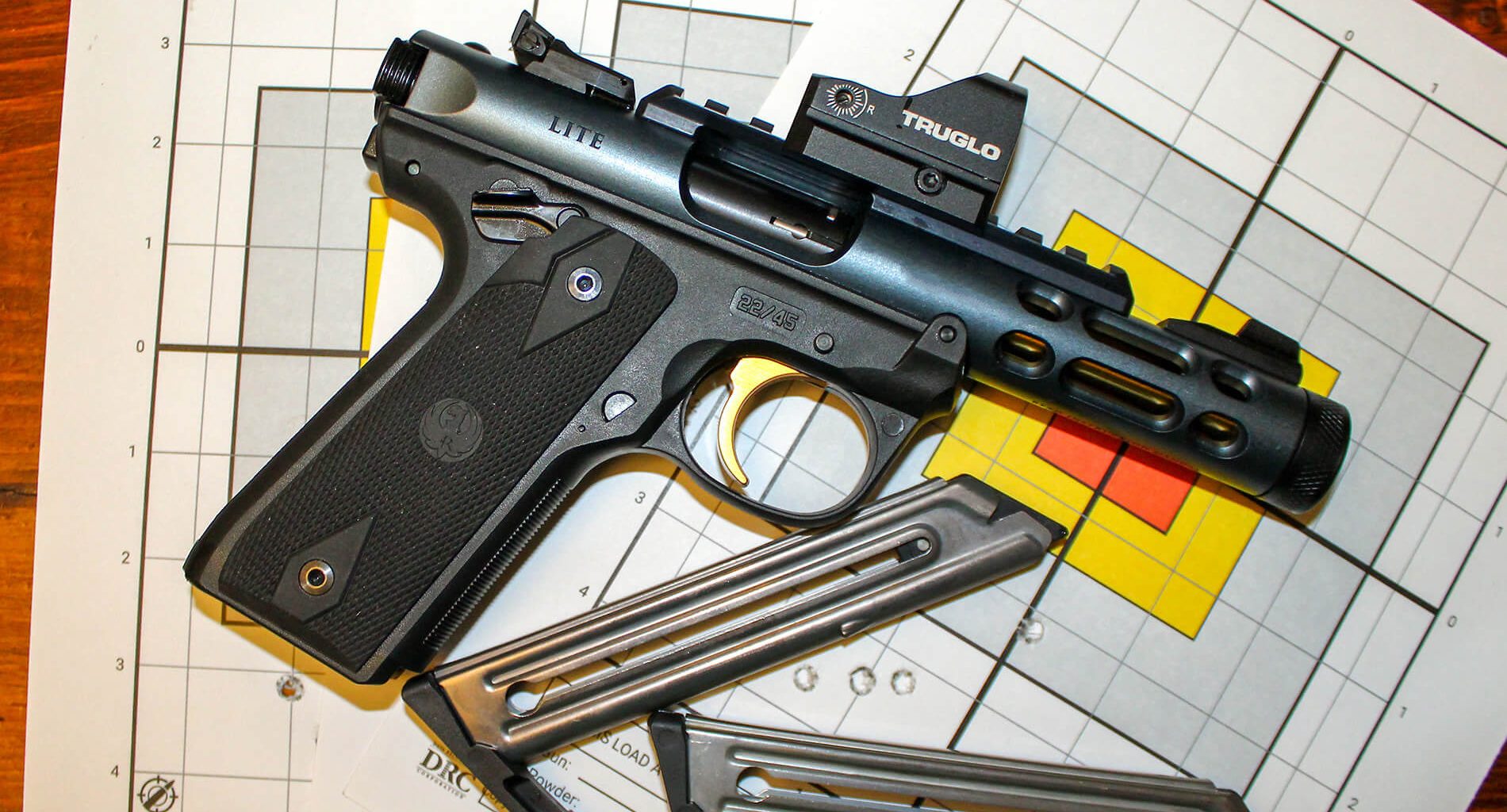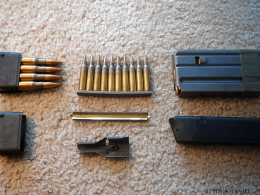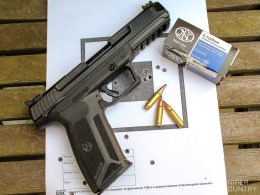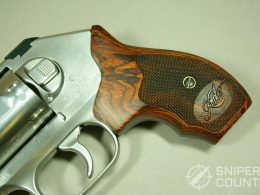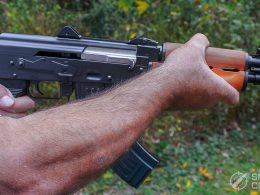In this Article:
A small, light .22 pistol can be a thing of joy. We don’t necessarily need a big, honkin’ gun on our hip all the time. There are times when we want to travel light and don’t want two-plus pounds of pistol weighing us down. There is room for a twenty-ounce or so in our gun safes, or at least I think there should be.
That’s where this pistol comes in. At 25 ounces, this is one gun that might get grabbed as we venture out for a stroll around the property or a quick trip to the range. Having owned both Mk I and II Ruger rimfire pistols, I will say that they are in the running as one of the more practical, fun guns you could take with you for recreational purposes.
As a Ruger owner, I’ve come to expect certain things from so-branded guns. Matter of fact, I’ve included my personal experiences with Ruger guns in more than one review or round-up. You can go here to read about Ruger rimfires. Check this out for some general thoughts about Ruger handguns in general. I could reproduce all that here, but it makes more sense to just hit the links and then come back. One thing about Ruger guns, I’ve owned a bunch of them and have handled even more. There is just a feeling you get with them, they are truly built tough. Some say they are over-built. Don’t know about that but I do know that it takes a lot to blow one up. We’ll leave that there!
History: Ruger’s, And Mine With The Brand
The Ruger rimfire family has a long and storied history. If you clicked on the rimfire link above, you read a bit about the Ruger story. Here’s a quick summary for those not reading the other review.
In 1949, Bill Ruger and Alexander Sturm started a company called Sturm, Ruger and Company. No surprises there. Basically, Bill Ruger wanted to build .22 rimfire pistols and Sturm backed him. Ruger had had experience with the German Luger, Japanese Nambu, and Colt Woodsman. He built his Mk I Standard rimfire, advertised it and the rocket left the launch pad. Today, Ruger is the largest builder of firearms in the U.S.
In the first review linked above, I recount how I owned a 1976-built Mk I that my high school band that I was director of gave me as a going-away present when I left that school in 1978. As I have mentioned in several other reviews, that sure wouldn’t happen today! At any rate, I liked that gun. Later, I owned a Mk II 22/45. (Why “22/45?” Because the caliber is .22 but the frame and grip angle is reminiscent of the ubiquitous 1911, known for its chambering in .45 ACP. That’s why 22/45). Both of the guns were good shooters, and accurate. Let’s look at them in a little detail.
BONUS OFFER: Get your free shooting range targets to print at home!
Get your free targets to print at home!
Mk I-II-III-IV?
Ruger’s rimfire semi-auto pistol history can be broken up into segments.
- MK I: produced from 1949 – 1982
- Mk II: produced from 1982 – 2004
- Mk III: produced from 2004 – 2016
- Mk. IV: produced from 2016 – present
The differences between the Marks illustrate a natural progression of upgrades, with many, many variations built throughout the years. Those included various barrel lengths, construction materials, barrel configurations, sights, grip materials, and configurations. For a fairly complete exposition of Ruger’s Standard rimfire pistol family, go here.
But…The Best Upgrade Is…
I recall taking my first Ruger apart for a complete cleaning once. I don’t remember doing that at all with my second one. Why? Because it was a purple pain in the posterior to do so. Or, more correctly, to reassemble the gun after cleaning. I remember I had to hold my mouth just right, swing a dead raccoon over my head three times in an empty parking lot on a Thursday, and then proceed to get the gun back together after a thorough cleaning. OK, maybe the raccoon is an exaggeration but the process was extremely frustrating. I just saw, in a gun magazine last night, an ad for a part that replaces the original Ruger part that allows you to get the gun put back together more easily.
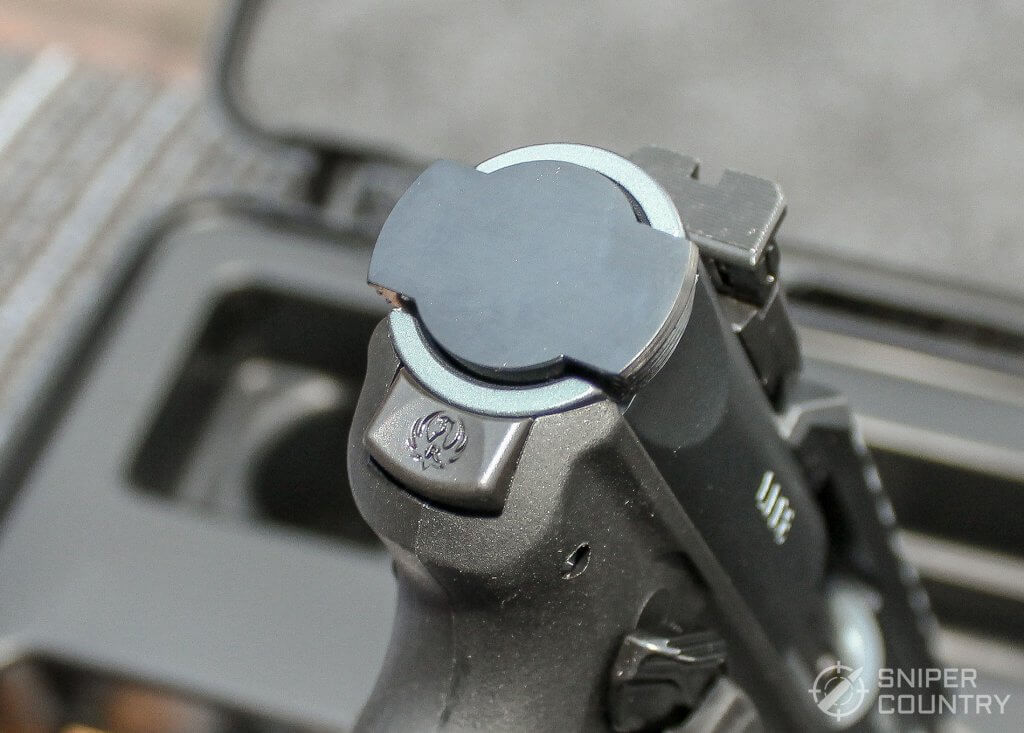
The best upgrade of all as I see came with the Mk IV series, what our sample gun is. All you have to do is press in on the button at the rear bottom of the slide and tilt the barrel down. Remove the barrel and slide, pull the bolt and clean away. It takes longer to describe the process than to do it. I recently bought an S&W Victory .22 pistol that has a pretty simple takedown, it only involves removing one hex-head screw, but it is dripping with complexity when compared to the Mk IV’s one-button-press procedure. In my humble (but experienced) opinion, that is probably the best upgrade Ruger could have done. Let’s face it, they’d already twisted the Standard platform about every which way it could go with barrels, sights, frames, etc. so it only made sense to do something that would make cleaning the gun easier. I can only imagine the number of Ruger pre-Mk-IV rimfires that have not been cleaned much (if any) simply due to the anxiety and frustration caused by taking them apart and not being able to get them back together. I’ve known folks who actually took their pre-MK-IV pistols to a gunsmith to reassemble.
That being said, another upgrade (or feature, depending on how you look at it) is the threaded barrel. Ruger makes it easy to buy a pistol with a suppressor designed for that gun (and its stablemate, the Ruger SR22). If your dealer is set up for suppressor sales (my local one isn’t), you can order both from one company, do the paperwork and you’re done. With that suppressor and the right ammo, this would be one fun gun.
Photo Gallery
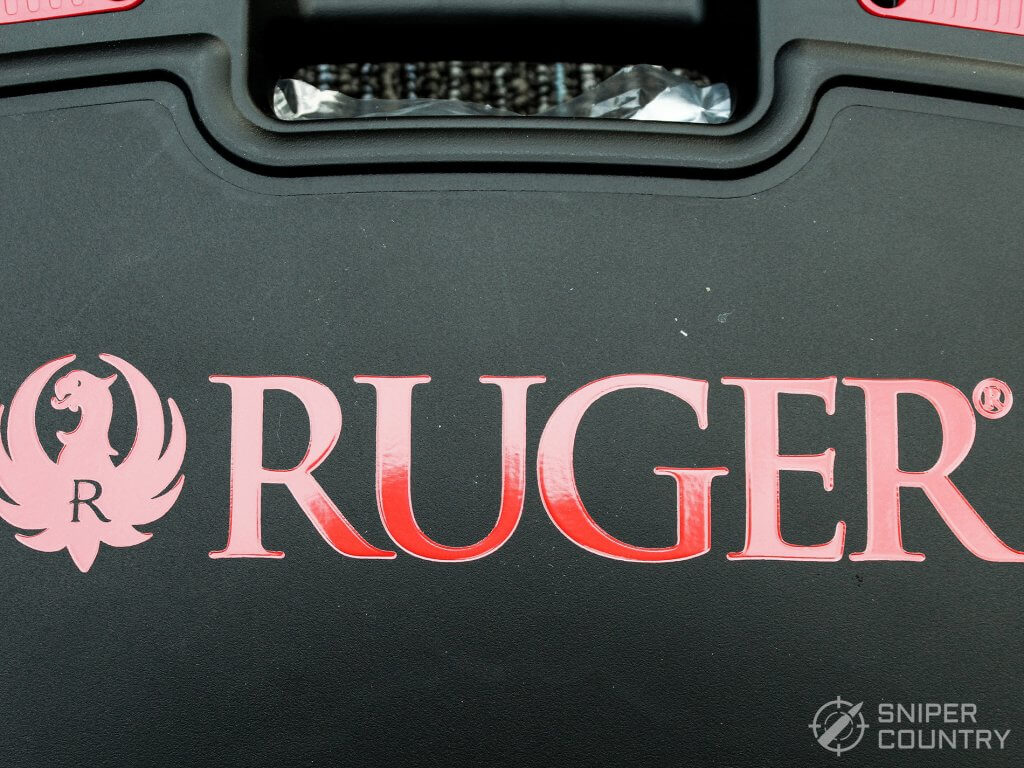
I do like Ruger’s new box. It’s very protective. The branding looks like a small, portable billboard.
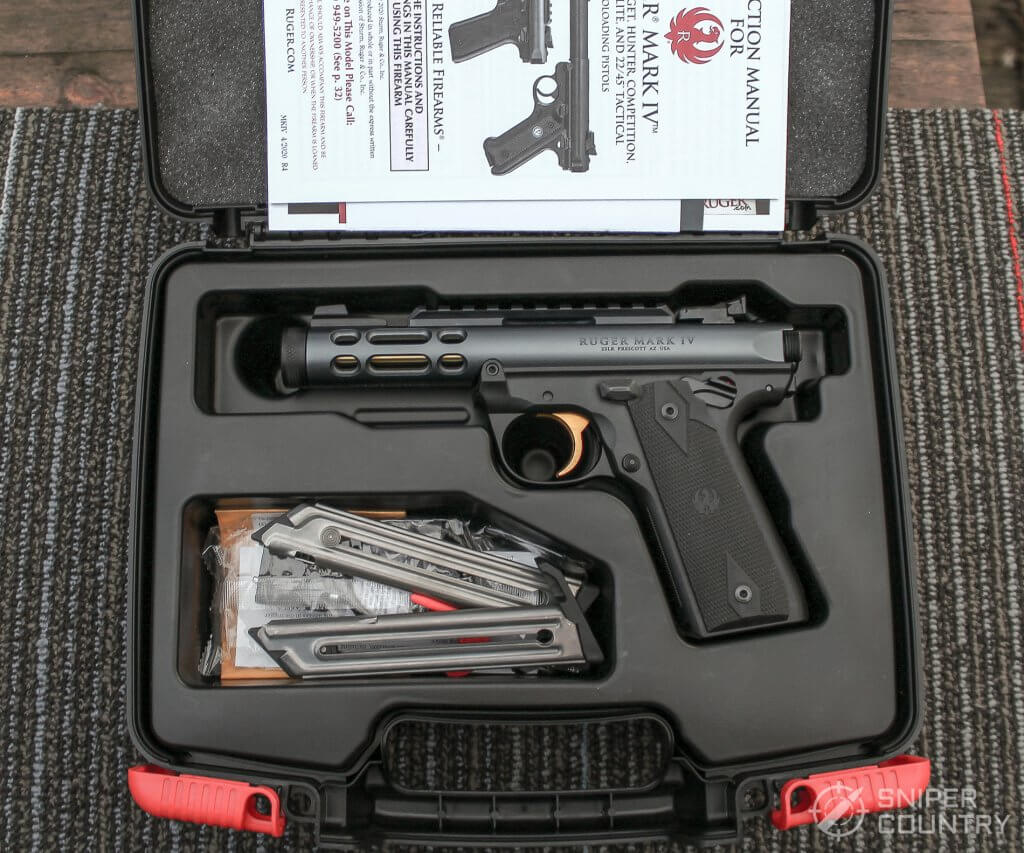
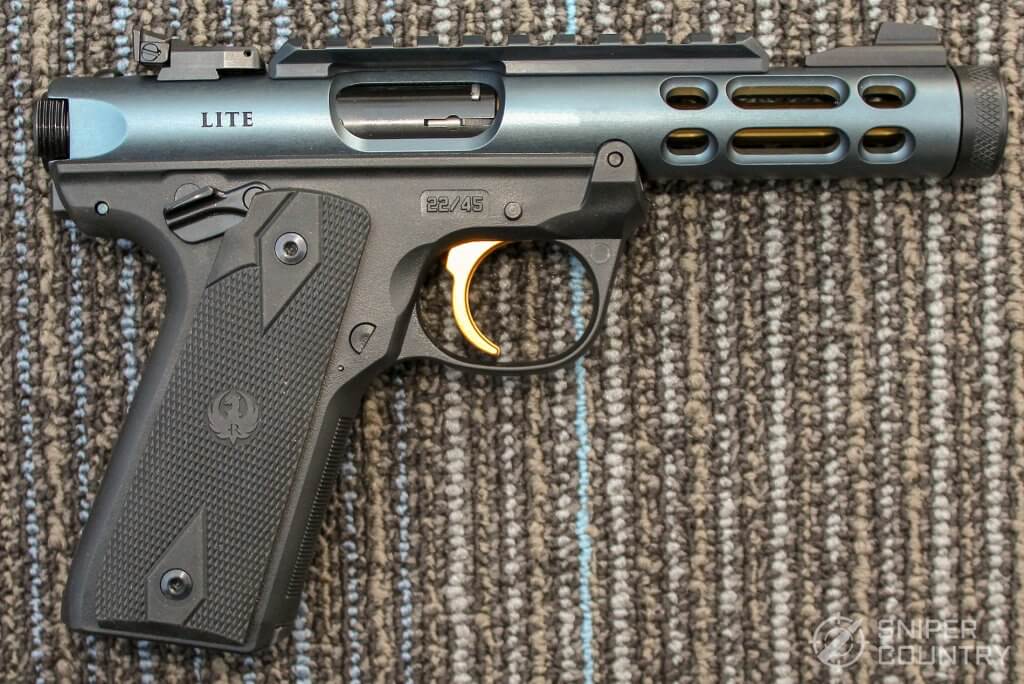
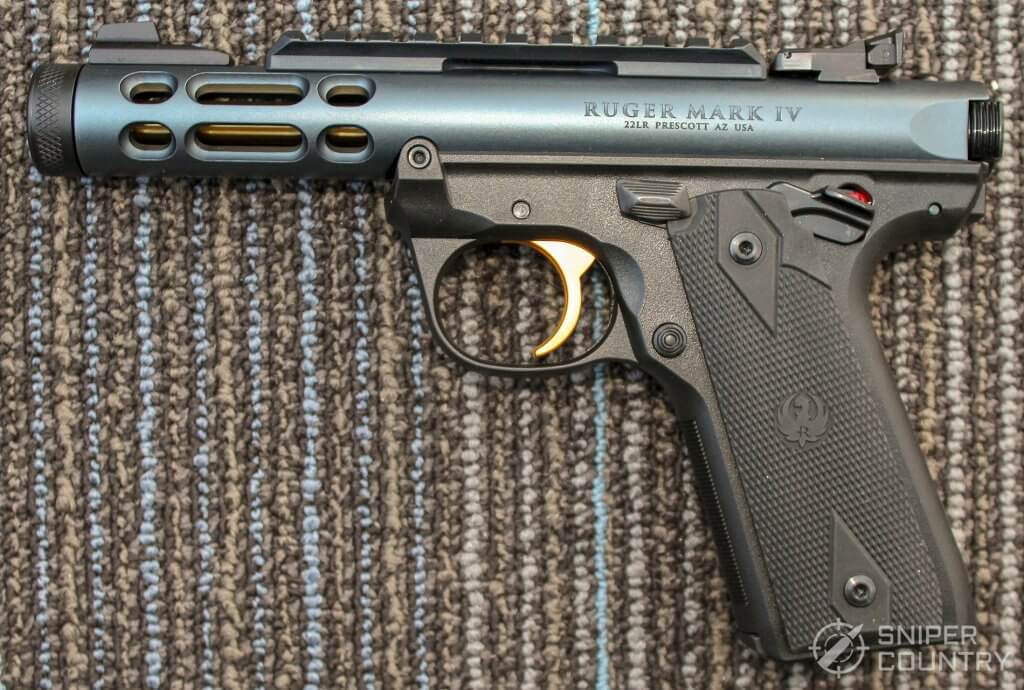
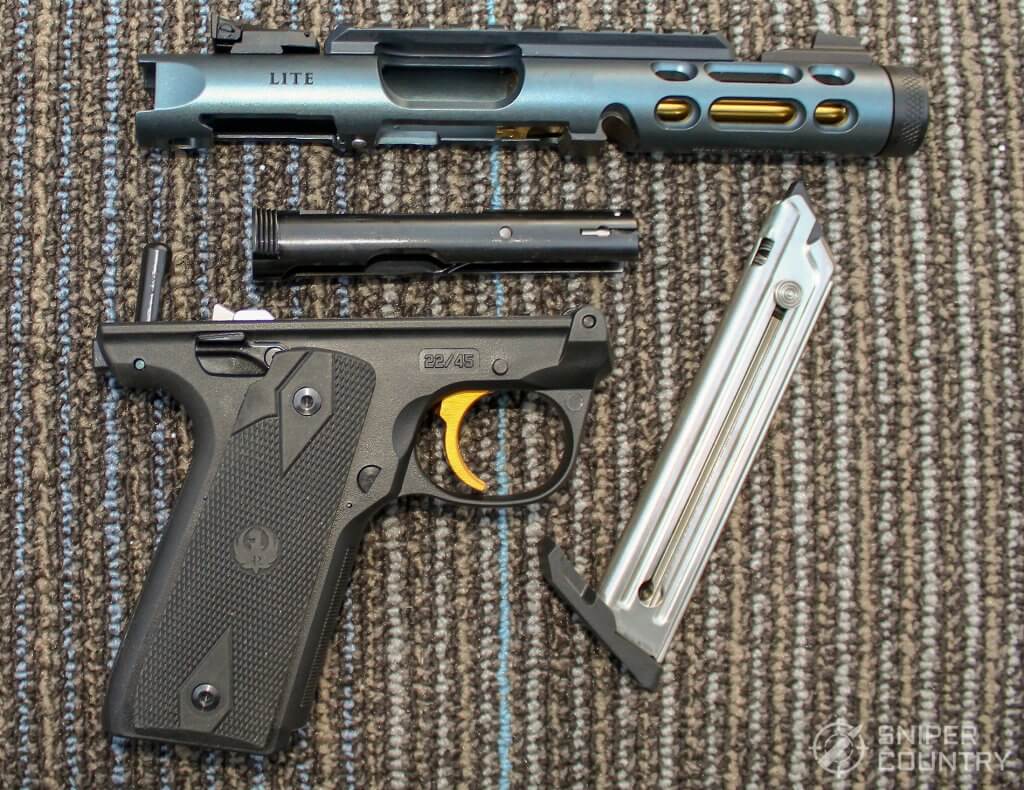

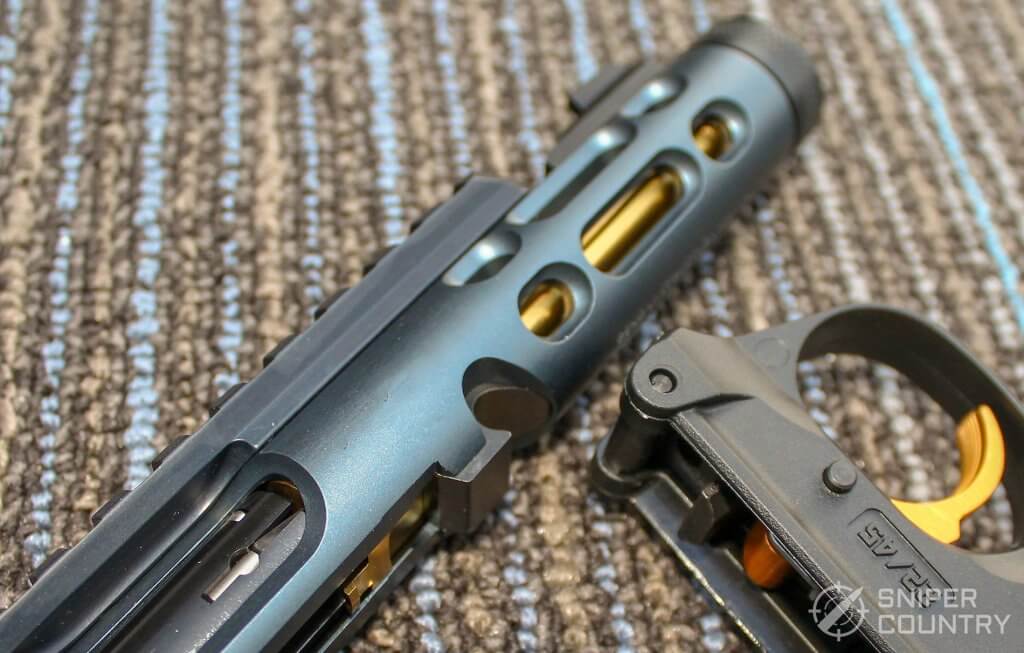
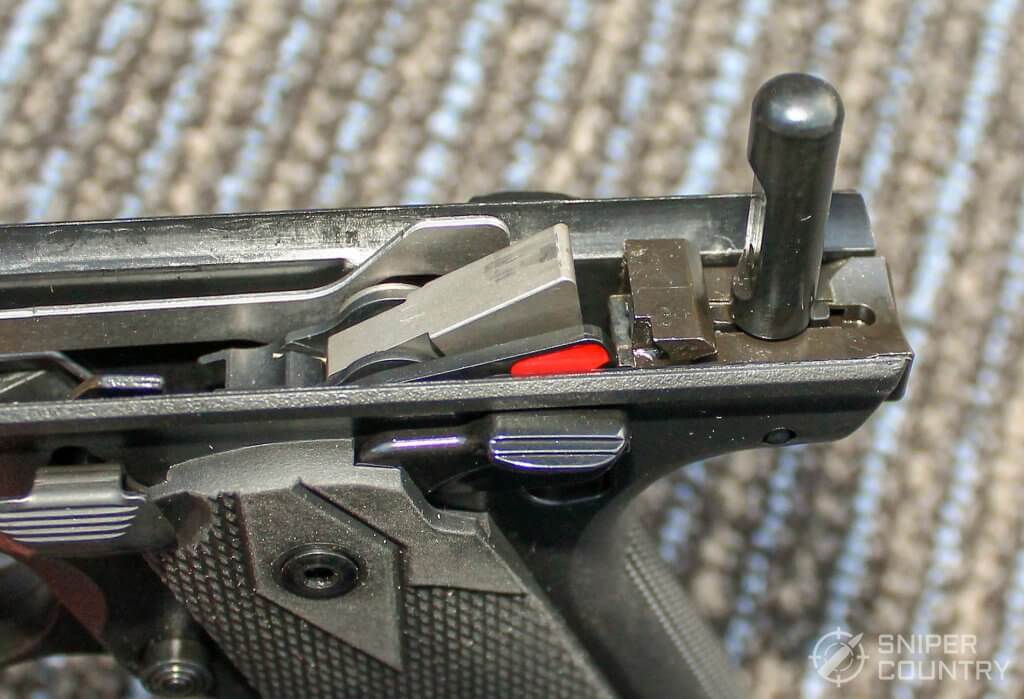
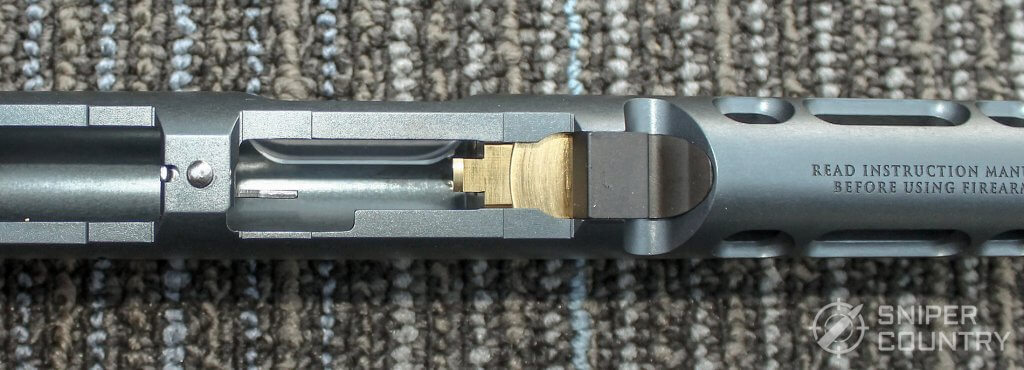
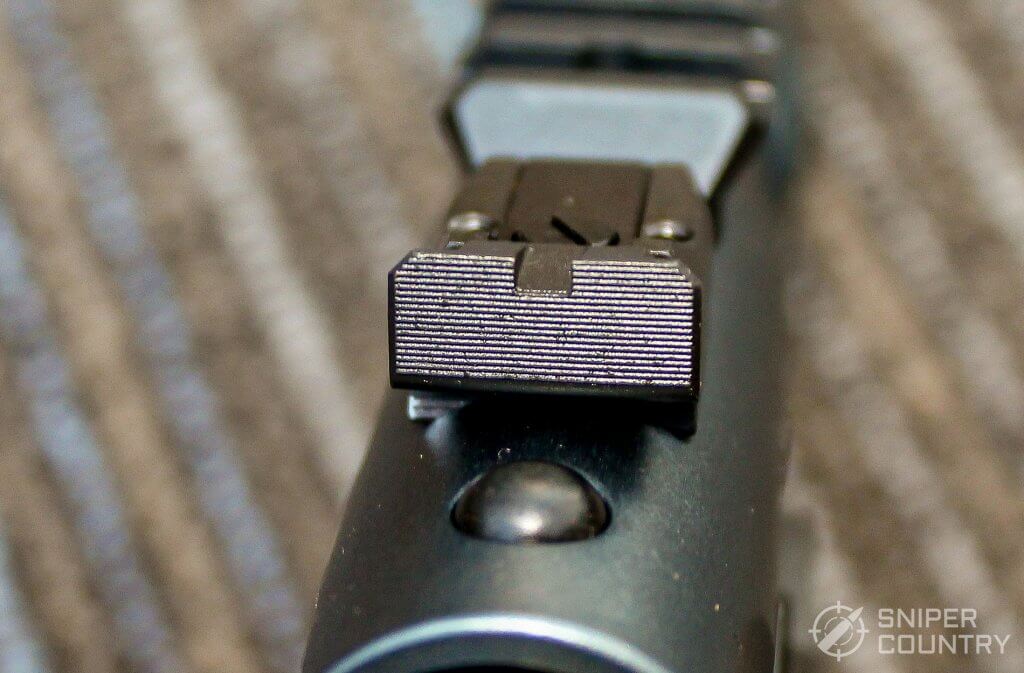
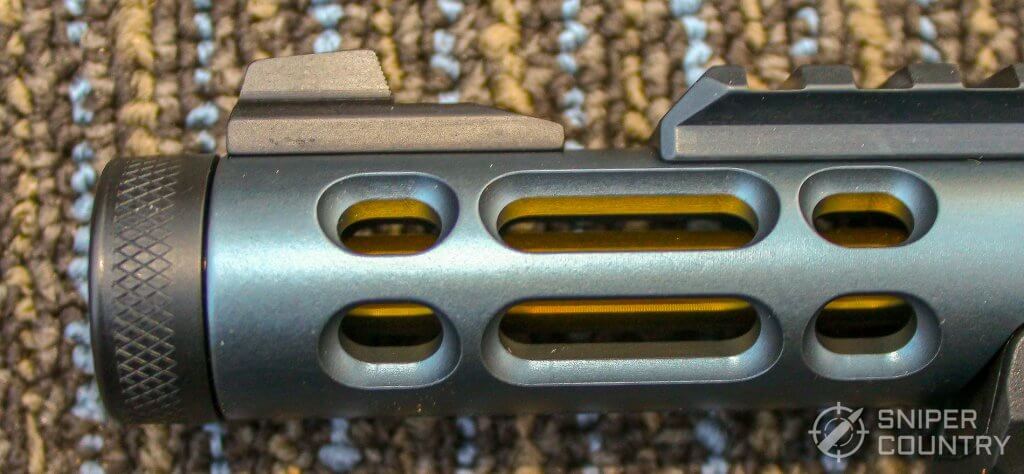
I think these slots helped in producing a pretty big flash with every shot. I could be wrong, the barrel’s not ported, but it was interesting at dusk!
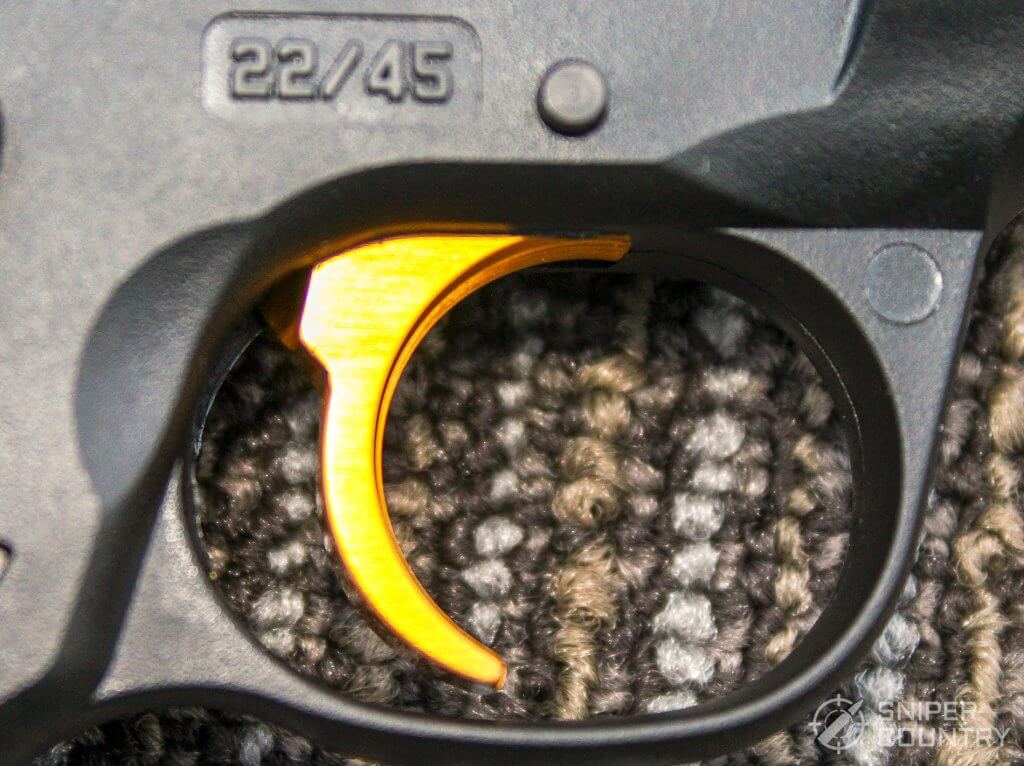

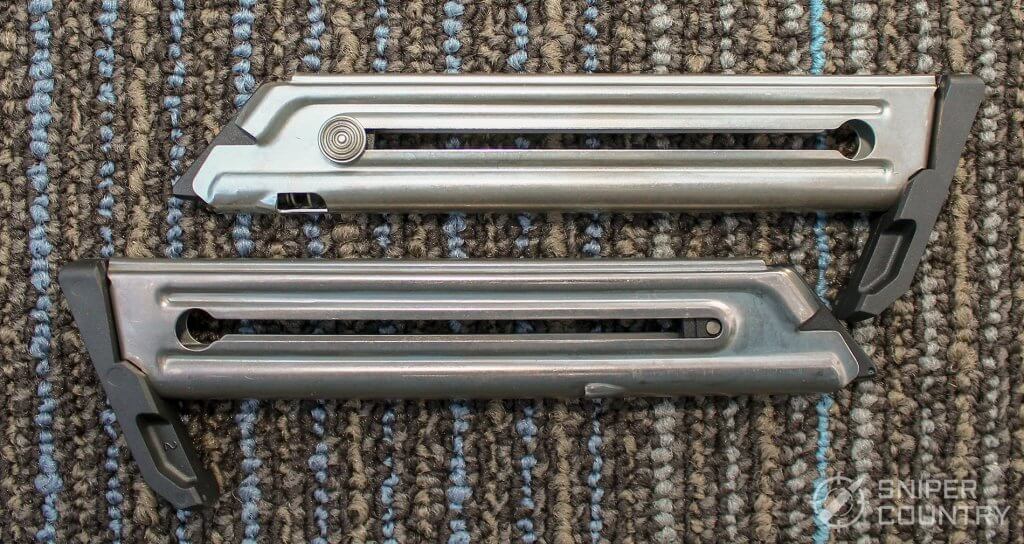
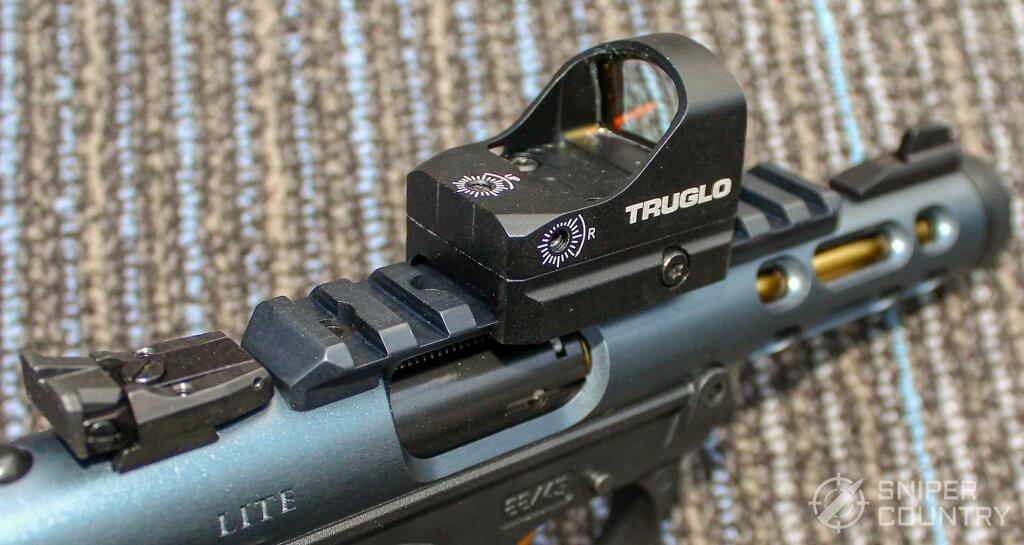
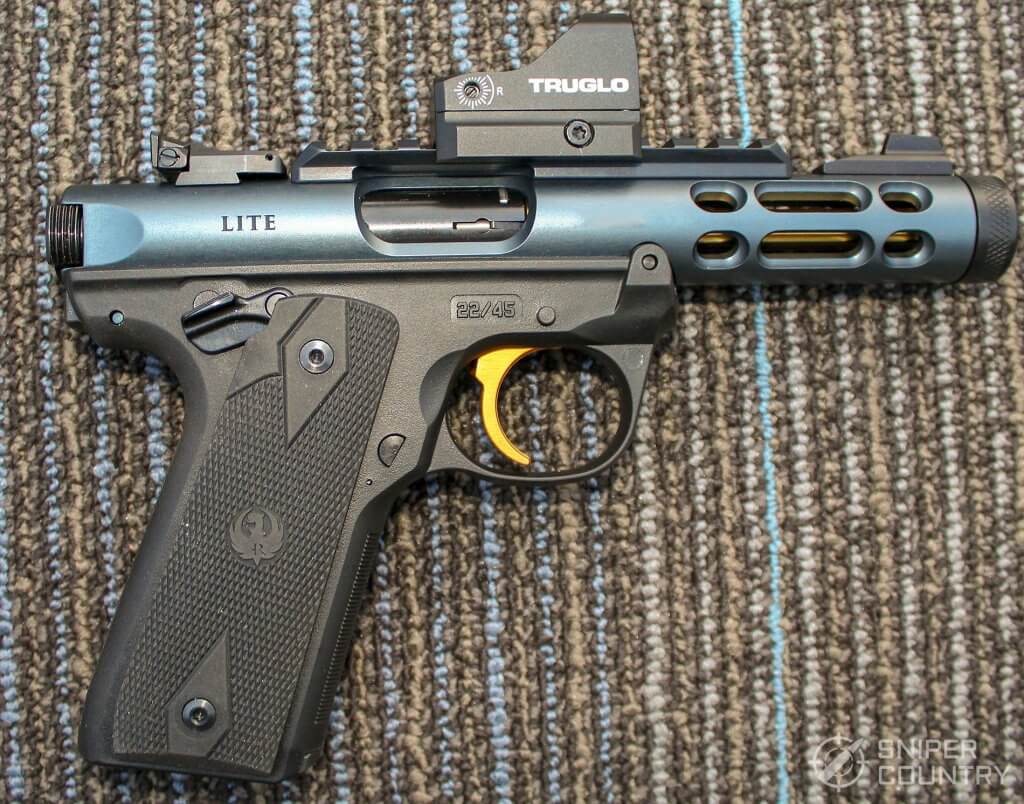
And, for those who are so inclined, stick a red dot on the Picatinny rail.
Specs & Features
| Overall Length: | 8.40" |
| Height: | 5.50" |
| Width: | 1.22" |
| Weight: | 25 oz |
| Capacity: | 10+1; two magazines included |
| Barrel Length: | 4.40" |
| Barrel Style: | Threaded 1/2"-28 |
| Trigger Pull, measured: | 3 lbs., 8 oz. |
| Sights: | Rear adjustable, front fixed |
| Receiver Material: | Aluminum |
| Grip Frame: | Polymer |
| Finish: | Diamond Gray Anodized |
| Warranty: | Lifetime Service |
| MSRP: | $559.00 |
| "Real-World" Price: | ~$480 |
Features
- One-button takedown
- 1911-style checkered grips; 1911 grip angle
- Compatible with Ruger’s Silent-SR supressor
- Picatinny rail for optics options
- Ambi safety can be converted to left side only
Uses For This Short-Barreled .22 Pistol
One area I like to touch on in my reviews of guns concerns usage. We all tend to buy guns to fulfill certain needs, or at least I do. Conversely, I know folks who buy guns just because they were in the gun case and they looked cool…wish I could afford to be that way. For me, a gun needs to be purpose-driven, at least a little. My deer-hunting area is just across the road from our house so I tend to think about guns that would work for that purpose. Never mind the fact that I am not a rabid deer hunter. It’s just nice, thinking that this .44 would make a great deer gun or that .350 Legend would work at the ranges that I typically see deer. Anyway, I tend to do that.
So, what purpose do I see for this .22? Deer hunting. Oh, sorry, got carried away. Actually, if I found the right brand of ammo that it liked and was accurate with, I’d stick a pistol red dot on it and take to the squirrel woods. A gun this size, even with a reasonably-sized red dot sight, wouldn’t take up a lot of room in a backpack. You could find or modify a holster and carry it on your trips to the range, or trips to your grain elevators or fence rows, if you lived in the type of area I do.
We’ve had critters from the neighboring woods and fields visit us from time to time, more often now that we’ve added chickens to the mix. I remember the weasel that one of our cats dispatched. Now, we’ve all seen the Warner Bros. cartoons with the weasel and Foghorn Leghorn but this did not pretend, there was a weasel dead in the yard. That’s the type of critter I alluded to above. Not to mention the coyote symphony we hear coming from close by in the fields across the road, which sure gets your attention. And, many years ago, our oldest son literally jumped out of his sandals when a bobcat cut loose about 15 yards from our woodshed. Would I purposefully go after a coyote, bobcat or any larger predator with a 4-inch-barreled .22? Of course not. It’s just that you never know when one of those critters will make an appearance. I could post, here, the photo I took of two coyotes 108 yards away from our front door but I won’t, you get the point. Sometimes, as in concealed carry, the gun you have with you is way better than the one you left in your nightstand. At least you could scare the thing away.
To sum up uses for this gun, I’d say use it for whatever you desire, that’s legal. It shouldn’t disappoint.
Shooting The 22/45 Lite
The lightweight aluminum frame really helps when you carry this gun around but not so much when you shoot it. Now, I’m not saying that the lighter frame ruins the shooting experience. After all, many shooters enjoy the balance this gun presents in your hand while you shoot it. To me, it seemed like it could be just a bit muzzle-heavy, maybe that’s why they relieve the barrel shroud in front of the trigger guard. That removes a few ounces of weight and helps to stabilize the gun in your hand. Anyway, the gun shot very well.
As with just about every other shooter in the known universe, I can’t find ammo to buy at my local haunts. (Well, at least here on Earth, not sure about Martian ammo supply). If it’s centerfire, I can reload for it. Rimfire, no way. Consequently, I shot just a few loads through our test gun.
Here are some targets I shot. I stuck the red dot sight on the rail but had not adjusted it. It was getting dark and I was in a hurry. So I had to improvise an aiming point at the top center of the target, as the dot was set very high. I was really impressed with the Federal load, even considering the make-do, not-very-precise aiming point. The group is 5 shots, not too bad!
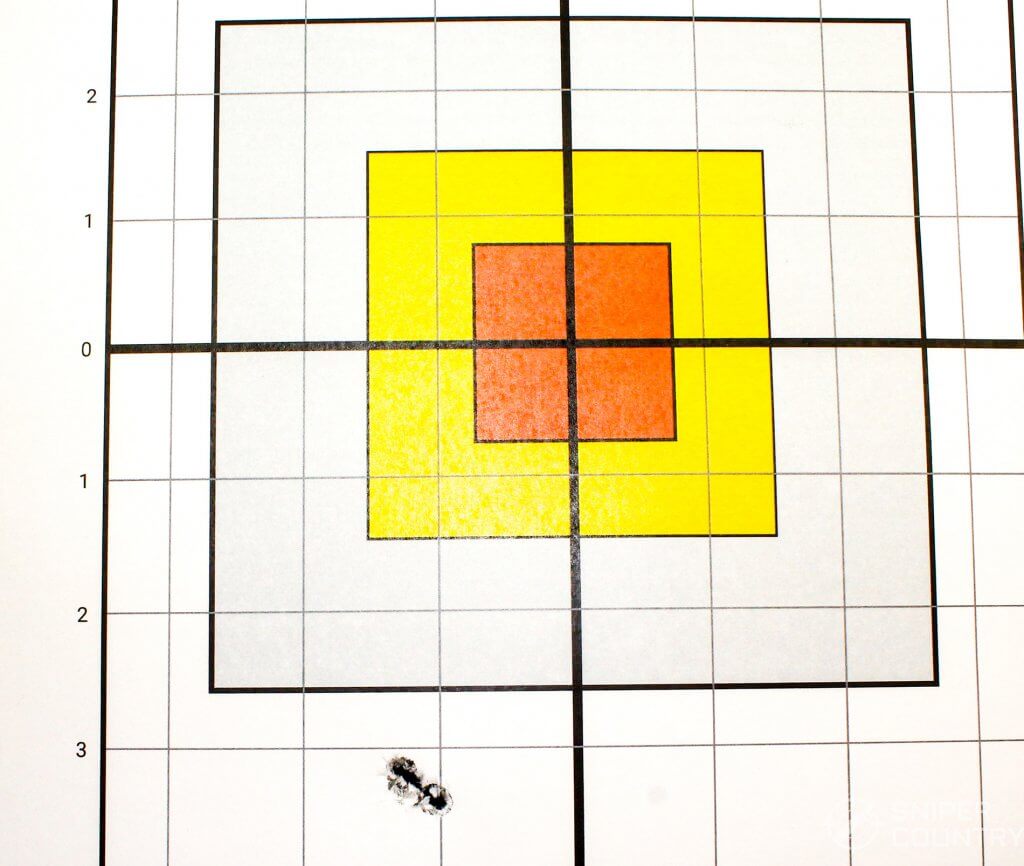
HP this was obviously the most accurate of the three loads I tried.

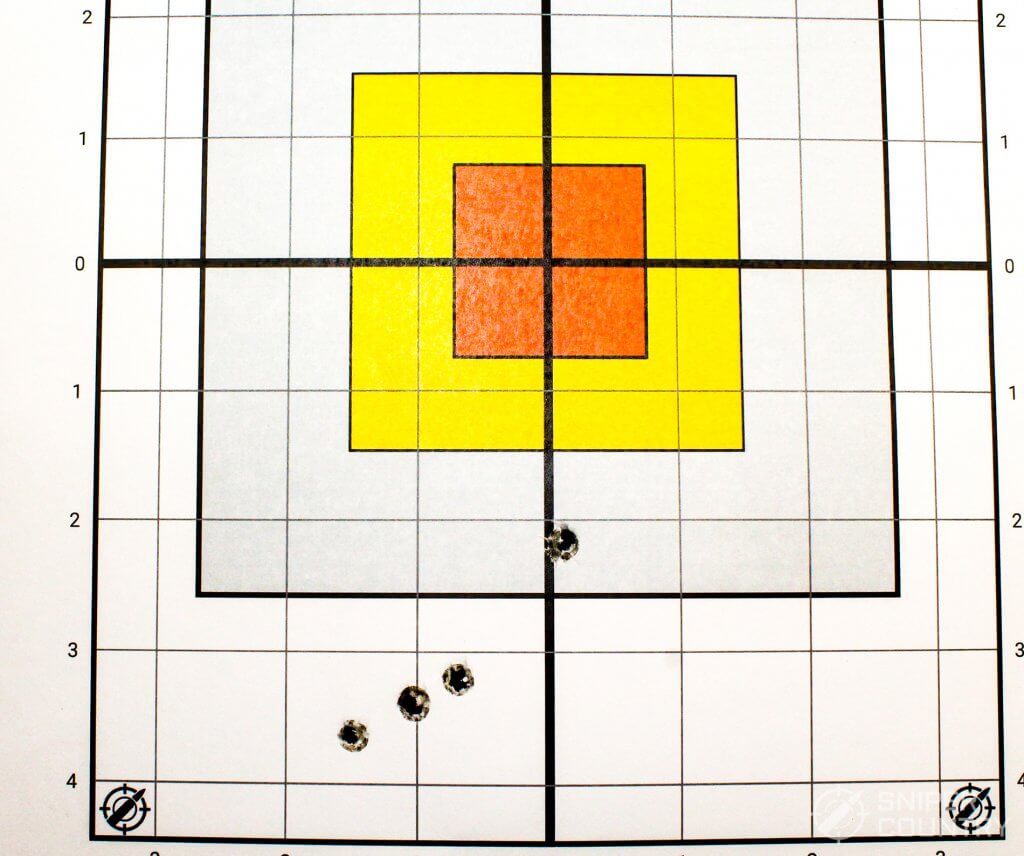
In terms of the trigger, it had a small amount of creep with little to no take-up. The break was crisp, light, and consistent. That decent trigger helped in the accuracy department, as is evident above. As you can see, the gun should be a winner if its owner has a chance to try several different types of ammo in it and then selects the best of the lot. It sure started out in a good direction. The sights would help, too, if I had used them. I really appreciate having an adjustable rear sight on any kind of .22 handgun, you never know which load you try will be the best, and you need to be able to adjust the sights for it. And, as mentioned elsewhere, I stuck a Tru Glo red dot on it just because I could, the Pic rail made it easy. I find that the red dot I put on my S&W Victory really helps in getting tight groups, my glasses preclude my shooting my best, it seems, with open sights. The trifocal aspect makes it hard to focus on everything that needs to be focused on. Anyway, the red dot helps. If I were to add this to my gun cabinet, it would sport a red dot. Here’s more on that subject.
Red Dots Vs. Open Sights
As I get older, my vision is not what it once was. That is no big surprise, especially to any older shooter. Trying to focus on three focal planes at once, rear sight, front sight, and target, especially with the front and rear as close together as they are on this Ruger .22 are not easy. I know, you don’t really focus on the rear sight, you just center the front sight in it, even so, it’s not what it was. A loyal reader recommended quadfocals, four distinct focus bands in your glasses. That sounds interesting but I have discovered an easier way to get on target, red dot sights. Again, this is not exactly news but I was late to the party. I am retired from teaching and as such have to watch what I spend on my shooting hobby. I finally bought an inexpensive red dot, the $25 variety, that I stuck on my S&W Victory .22. I have, since I’d done that, received another red dot or two for review. These sights are the answer, at least for me. I will take a look at this Tru Glo sight in a future review, suffice it to say, it works. I highly recommend shooters who are on the downward slope of the vision hill to check out red dot sights, as I said above, you can get one that works for around $25. Lasers are good, too, but tend to have more limitations, range, and ambient light being two. They are usually a short-range proposition that tends to work best in darkness or near-darkness. I have one of those on a pistol and like it (especially when the cat comes out and sees the dot on the floor, talk about cheap entertainment!), as it is great for short-range fast shots. This Tru Glo red dot really helped. Anyway, that’s my plug for red dots. I figure anything you can do that helps you as you engage in your hobby is a good thing, and these sights do help me engage in mine.
Using a red dot on this Ruger provides a natural, fun shooting climate and should lead to a lessened ability to put the gun down and go home from the range.
Conclusion
I always like it when I get to the “Conclusion” (or whatever I call it) part of a review. I usually ask the question “what did I think of this (gun)-(sight)-(reloading gizmo)?” Most of the time, I liked whatever it was. That’s not unusual, I tend to review things I like. OK, so how does that apply to our little Ruger 22/45 Lite? I like it. No surprises there. I at least have a basis for comparison, since I’d just bought the S&W Victory a few weeks ago. How does it compare? Well, it’s lighter and smaller (mostly), and as much fun to shoot. I’ve only had one .22 semi-auto pistol out of all the guns I’ve owned over the years that I didn’t like. That gun would not shoot two consecutive .22 rounds without my helping it eject the old case and load the new cartridge. It is essence was a single shot and shall remain nameless. But only one gun out of all those others, not too bad! This Ruger would definitely be on the forefront of rimfire pistols that were ready to be brought into action at a moment’s notice. Its smaller size, balance, accuracy, and style would enable this little gun to be brought to bear quickly. Whether you are racing a hand-held shot timer or trying to get that !@#$% varmint before he gets out of your chicken yard, you would have what you need close at hand. Pop a red dot on the rail and you’ve just added to its usefulness. I do think that this .22 would be a great addition to any gun collection. If you own one, let’s hear from you below. As always, keep ’em in the black and stay safe!

